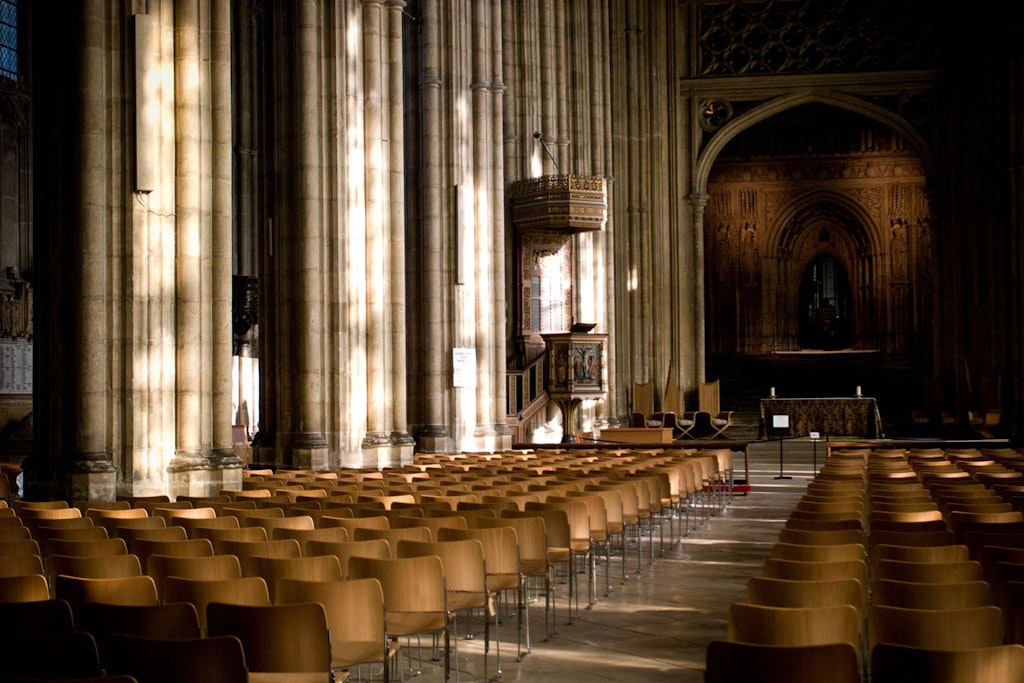What are our cathedrals for?
Changes to the management of cathedrals have obscured the very point of their existence
Sam was cold. He had spent the night in a homeless pod which, being designed to stay warm through the night via the solar energy gathered throughout the day, wasn’t much good when the weather was cloudy and grey. He had come into the cathedral to hunker down by one of the great gas gurneys for warmth. I spotted him almost immediately, there aren’t many other visitors that lie on the floor after all, and the vergers had spotted him as well. What was he going to do next? Would he upset the other, more respectable, visitors? His presence gave a startling manifestation of the challenges facing our cathedrals. Cathedrals have been trying to maintain a balance between several competing priorities for some time now and it is an almost impossible feat.
As a priest in the Church of England, I had the fortune to spend some time working at a cathedral and meeting the various departments that help make the place tick and having done so then it had been interesting to watch the furore over the recent decisions by several cathedrals to host a silent disco in the nave. While personally opposed to such an idea I have some sympathy with the position that cathedrals find themselves stuck in and thought it may be worthwhile to reflect on why this is the case.
… but of course praising God is difficult to quantify on a spreadsheet
The first and main competing priority might be understood as on the one hand maintaining the cathedral as a place of Christian worship over and against running the place as a business operation. My particular cathedral ran a deficit of almost £400,000 in 2022 and those in charge of the commercial arm lobby had to “sweat the assets” in order to try and close that gap; assets to be understood as the building itself, the choir, the historical artifacts, various properties and so on. The choir is excellent and well cared for, and they see a key element of their role as praising God daily. This is one of the founding principles of any good cathedral you might think, but of course praising God is difficult to quantify on a spreadsheet, other than in a (negative) cost sense. Good choirs are expensive. Now we recognise that a choir brings something almost undefinable good to a cathedral, and people come into the building to hear them sing, but when the average donation per visitor is 78p (My cathedral doesn’t charge an entrance fee) then perhaps it is easy to understand that the operational wing might think that on the one hand, the choir needs to pull its weight, and yet also look elsewhere for its income. There is a certain mindset that sees cathedrals as a cool venue that can make money, but when visitors are stingy then you end up with silent discos.
This first tension has been exacerbated by the 2021 Cathedral Measures act which, because of accusations of financial incompetence, has turned cathedrals into charities with a trust deed and while having “due regards for the cathedral’s ecclesiastical purpose”. This means in practice that the clergy are no longer fully in control of their own building. A group of (lay) trustees are instead, all brought in for their excellence in certain areas — namely finance, operations, safeguarding and compliance — all words to strike a chill into the heart of any priest who believes they have a mission from God to fulfil. Not because these things are bad in and of themselves, but they tend to spread and grow in order to justify their own existence and so if not managed very carefully will pull down the cathedral’s ecclesiastical purpose with hundreds of silken threads with names like “risk management”, “monitoring”, “audit”, “welfare”, “policy review” and so on. The outcome being that the money raised by the cathedral through events will ultimately come to simply fund the operation. All the other challenges and tensions I will discuss spill out from this underlying problem.
The second tension is between the needs of the respectable visitors and the homeless who often see a cathedral as a short-term place of safety and (relative!) warmth. Sam was being given the side eye by the staff who, having been encouraged to no longer provide free teas or coffees to discourage the homeless seeing the cathedral as a place of respite, brought this challenge to reality. He had been effectively othered by this decision; he wasn’t wanted, he made the place look untidy, no-one was quite sure what he might do and the bottom line was that ultimately he might upset the (78p) paying guests — although of course they can always escape to the well-stocked cathedral café where a lukewarm sausage roll, and salad will set you back almost £10. Sam was able to stay for a few hours, he kept out of the way and eventually shuffled on, to some relief.
The third source of competition is between the mission of the cathedral; that is to say the regular eucharistic services, the work of the (volunteer) day chaplains who spend most of the day walking the transepts, meeting and greeting people, praying with them and offering counsel, the healing services where prayer is offered often with a touch on the head or shoulder and where the Sacrament of confession is offered versus regulation. In spite of good intentions, this means in practice that you can’t touch someone because they might deem it as inappropriate, you can’t hear a confession because they may tell you they’re a terrorist or a paedo, you can’t serve coffee unless you have been DBS checked or completed all the various safeguarding assignments, you can’t be an old lady who has served in the Broderers Guild at the cathedral for 40 years because you struggle to get upstairs and so become a health and safety hazard. All in all, regulation, however well meaning, has been an absolute death knell for an entire army of volunteers who have worked at the cathedral for decades, but who struggle with completing online DBS checks and safeguarding training. Given that the cathedral faces a dearth of volunteers post COVID anyway, this is a loss it can ill afford.
A fourth challenge is balancing the tradition of the cathedral, that is choral music, the eucharist, robes and cloaks — which admittedly all contribute to the creation of a certain Edwardian vibe — and the desire to be accessible. The amount of people (both clergy and lay) who told me that “yes it’s all very nice but we must become more accessible” was significant, and of course being accessible generally can be translated as dumbing things down because the poor dears just won’t understand what is going on, when perhaps the reason they are attending is so that they can experience something transcendent. The reported positive trend of attendance of choral evensong seems to support this. It has been interesting comparing the Anglican desire to lower standards when compared to the reporting of writers like Paul Kingsnorth and Martin Shaw who have gone into Eastern Orthodoxy largely because of the high bar set during the divine liturgy and the Orthodox Church’s disdain for the need to be up to date. The desire to be cool, which has infected the Church of England since at least the late 80s, is alive and well in cathedrals and in their sermons which attempt to reflect the zeitgeist of the times, although I always find it a few years behind the curve, and so is currently reflecting the pre 2016 liberal consensus.
All these tensions and stresses pull the cathedral in competing directions to the extent that it is difficult to move at all. Clergy do try and pull the direction of travel towards the mission of the Church but will always find themselves hauled back to the requirements of the Trust. The operational department will always find itself frustrated by the inability to really let rip as a commercial venue and they know deep down that there could be a lot of money made if they could just free themselves of those limiting factors.
… there is an opportunity for cathedrals to lead the way in a ressourcement of the national Church
In some ways the cathedral reflects the challenges of the parish church. It’s the same stuff just magnified by 1000 and so there is an opportunity for cathedrals to lead the way in a ressourcement of the national Church. Its magnified nature means that there is scope to really investigate the problems I have highlighted and, with the right leadership, take them apart and rebuild from the bottom up. While this is undoubtedly complicated, a good first step would be to create a clear separation of the two main sections of the Cathedral, what you might call Ministry Division and Operations Division, with the role of the Operations Division being the junior member in a supportive role and enabling Ministry Division to truly be the mother church of her Diocese. Cathedrals re-finding their purpose as a centre of mission and making a pathway for smaller parish churches to follow? There’s a thought. Otherwise, why bother going to a cathedral, or indeed church at all? Sell them off to the National Trust and let them be enjoyed as historic venues with entrance fees, concerts, discos, nightclubs and roulette nights galore. They’d make millions! Probably no place for Sam though — but then, maybe he gets that sense at present anyway.
Enjoying The Critic online? It's even better in print
Try five issues of Britain’s newest magazine for £10
Subscribe














